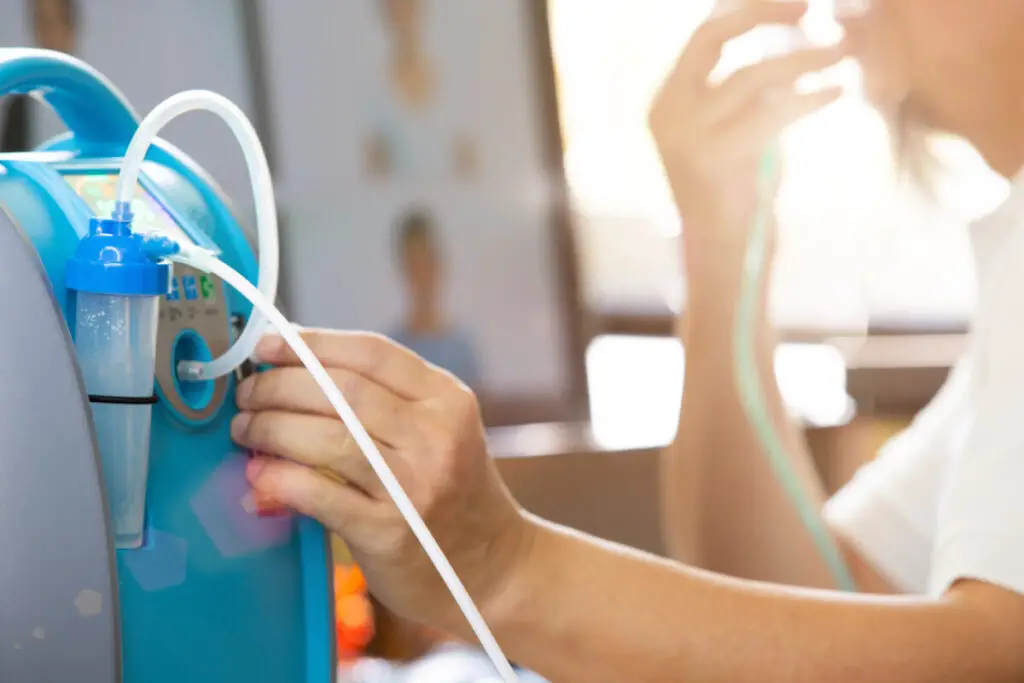Oxygen concentrators fulfill the oxygen needs of patients who cannot get the required amount on their own. Each oxygen unit equips a humidifier bottle that patients fill with water before using the machine. They, however, often question if they can use normal water in the device bottle.
Doctors recommend against using normal saline water in oxygen concentrators because it can damage the system, shorten its lifespan, and fails to provide adequate humidification for a healthy respiratory environment.
We’ll expand on the topic by discussing the right use of water in your oxygen concentrator to maximize its efficiency.

Why Use a Water Bottle With Oxygen Concentrators?
Because oxygen concentrators successfully meet a patient’s oxygen needs, one may wonder about the purpose and usage of a water bottle. Oxygen is a relatively dry gas. So, taking in oxygen without humidification can have adverse effects. For instance, it may lead to:
- Extreme discomfort
- Itching
- Scabby and sore nasal passages
- Nose bleeds
- Dry nose
A water bottle attached to a concentrator eliminates these issues. The oxygen catches humidity as it passes through the water bottle, moistening the air. This keeps the gas from being excessively dry and prevents potential risks.
The Best Water Type for Oxygen Concentrators
The World Health Organization shares guidelines on using water with oxygen concentrators. Because users show concern about the best water type for oxygen therapy, the health institution highlights a few points:
- Avoid using normal tap water – even if it’s safe for drinking
- Preferably, use cold boiled or distilled water
- Avoid using bottled water, even distilled, that has been placed in warm conditions for an extended period of time.
Exposure to a warm climate encourages bacterial growth in water. Eventually, it risks the patient’s health and may exasperate existing infections.
Further, Business Insider also shares guidelines on using a humidifier in an oxygen concentrator. The site recommends using filtered or distilled water in the humidification bottle.
It’s because the distilled water has been through the distillation process. Distillation is one of the oldest water purifying techniques, and it involves boiling the water until it evaporates and condenses.
This removes the impurities, including chemicals, bacteria, and heavy metals, from the water. Because the humidifier water passes directly to a patient’s lungs, individuals with respiratory infections must breathe in water free of contaminants.
Otherwise, it may escalate their existing respiratory problems. Further, besides making up for a healthy water source, distilled water protects the device and boosts its lifespan, unlike normal saline water.
You can also use water passed through Reverse Osmosis (RO) technique. Although it allows water molecules to pass through, it keeps away the contaminants, which is a plus for patients.
Attaching the Humidifier Bottle and Get Device Working
The World Health Organization recommends regularly washing, rinsing, and disinfecting the bottle when used for the same patient. However, it’s best to toss away the bottle if you’ll use the same oxygen concentrator for a different patient/users.
Here are some general instructions for using the humidifier bottle with the oxygen concentrator.
- Rinse the humidifier bottle with running water and add distilled water to the top scale line (avoid overfilling)
- Place the cap on the humidifier bottle and tighten it. However, avoid crossing the cap thread as it may cause a leak.
- Now connect the inlet nut to the humidifier adaptor, depending on your oxygen unit. Tighten the inlet nut properly but avoid crossing the thread to prevent oxygen leakage.
- Then, adjust the flow rate to 4 liters, block the outlet, and check the humidifier for leaks. The safety valve will whistle within a few seconds. If that does not happen, ensure the lid is tight enough.
- Attach the tubing to the humidifier outlet after correctly fixing the water bottle. Adjust the flow rate to the recommended level and use the concentrator.
Removing Water from Extension Tube
Because you need to change the humidifier water regularly, you must learn how to remove water from the extension tubing. Here are a few steps that can help you out.
- Disconnect the tubing from the humidifier and connect it to a consistent flow source – a backup tank.
- Tweak the liter flow to the maximum setting. This will ensure quick water outflow within a short time.
- Once the water flows out of the tubing, adjust the setting to the normal level.
- Connect the tubing directly to the oxygen concentrator or the bottle
Rinse the humidifier bottle in soapy water once a week. It will ensure optimal hygiene for the patient and reduce the risk of infections.
Steps to Using an Oxygen Concentrator
Oxygen concentrators are portable devices that provide consistent power. As such, they can operate 24/7 without compromising performance. If you aren’t sure how to use one at home, here are a few instructions to help you out.
- Place the oxygen concentrator 1-2 feet away from furniture and wall to let the air circulate. Otherwise, it may overheat the device.
- Attach the humidification bottle to the machine (as suggested in the guidelines above)
- Use distilled or RO water to keep the bottle bacteria-free and the patient healthy.
- The concentrators come with an air filter that concentrates the surrounding air. Place the filter before using the unit and wash it once a week with warm water. Besides, use it only after air drying.
- Switch on the machine 10-20 minutes before using it. This is because portable oxygen concentrators take a while to concentrate pure oxygen.
- Avoid using an extension cord in the concentrator because it requires more power and risks igniting the fire.
- You will hear the processing sound and see the light, indicating the unit is working efficiently.
- Navigate the liter control knobs and set the liters per minute per the doctor’s prescription.
- Check the tubing for bends as it restricts proper oxygen flow. Besides, there shouldn’t be any gaps in the sides of your mask.
- Those using a nasal cannula should move it upwards into their nostrils for high oxygen levels.
Oxygen Concentrator Maintenance Tips
There has been a surge in demand for oxygen concentrators in the past few years. More patients are now buying the device to meet their oxygen needs while at home.
This raises the concern of proper maintenance. We’ll share a few tips to clean and disinfect your oxygen concentrator and control infection spread.
i) Disinfecting the Exterior Case
Although weekly exterior cleaning helps, you must regularly disinfect if two patients use the same device.
- Turn off the system and disconnect the power supply.
- Use a mild soap or gentle cleaner and a damp cloth to clean the exterior case.
ii) Cleaning the Humidifier Bottle
You must handle the humidifier cautiously because the water you fill in it directly travels to the nasal passage into your lungs.
- Use sterile/distilled water and change it regularly
- Remove the water from the bottle and wash it using soap and water.
- Clean with a disinfectant and refill the bottle
- Avoid touching the bottle’s lid or interior after cleaning and disinfecting. This will prevent contamination.
- Add the water to the maximum scale and close the lid using hand gloves
Disinfect the humidifier bottle with an antiseptic liquid every 30 minutes daily. Plus, make sure to air dry it before using.
iii) Filter Cleaning
Because the oxygen unit consistently draws the air in, the filters get clogged with dust and debris. Therefore, you must remove them and wash them with soap and water. Air dry the filters after rinsing them.
You must dust off the filters every week and wash them monthly. However, this varies depending on how dusty your surroundings are.
iv) Avoiding Nasal Cannula Contamination
You must handle the nasal cannula cautiously to prevent contamination. It is better to discard it even if the same patient uses it. It isn’t uncommon for the cannula’s prongs to get contaminated when the patients leave them on furniture or bed.
Inserting the same cannula in the nostrils can transfer pathogenic organisms into the nasal passages. Gradually they travel to the lungs, leading to a respiratory infection.
Therefore, taking this preventive measure is a must to avoid exasperating existing breathing issues and leading to a more severe infection.
How Much Water Do I Put In an Oxygen Concentrator?
You must fill the water within the scale between the top and lowest scale line. Pouring less water won’t fulfill the moisture needs. Besides, it’ll evaporate sooner. Contrarily, adding more water will overflow the water bottle.
How Often Do You Change the Water In Oxygen Concentrator?
It is best to change the oxygen concentrator’s water regularly. The practice will minimize infections and keep the patient in good health.
How Long Does the Water Last In An Oxygen Concentrator?
How long the water lasts in the concentrator depends on the device’s usage. The consistently running system will evaporate the water sooner. However, the key is to replace the water daily, even if you have some left in the bottle.
Can You Use an Oxygen Concentrator Without Water?
Low oxygen flow therapies do not require humidification right away. However, doctors recommend it for prolonged treatments.
Neglecting the use of water with oxygen concentrators can lead to a dry nose, nose bleeding, sore nasal passages, itching, and extreme discomfort. Therefore, using the device with water is best to mitigate infectious symptoms and keep the patient healthy.
